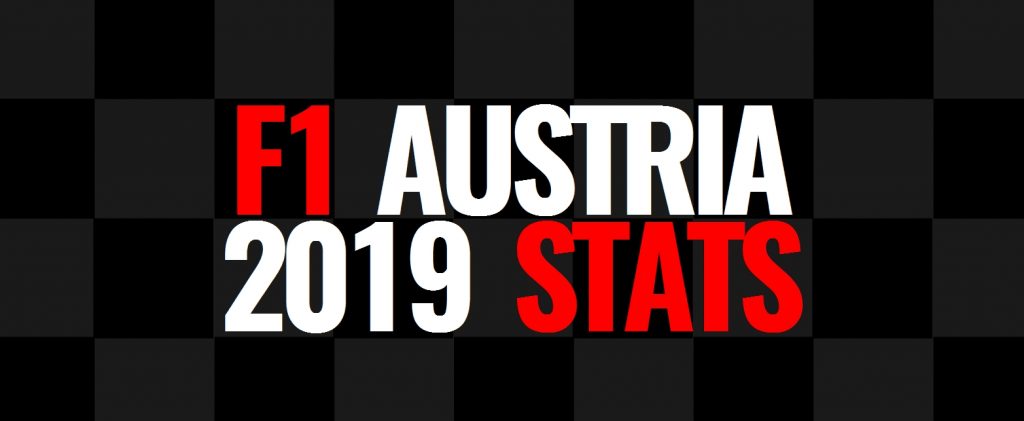The first win for Honda power since 2006, the youngest front row in F1 history and the first point for an Italian driver since 2010. Here are all the facts and statistics from the 2019 Austrian Grand Prix!
VERSTAPPEN VICTORIOUS
Max Verstappen ended Mercedes’ ten-race winning streak with his Austrian Grand Prix victory. It was his sixth F1 victory, and his second consecutive win at the Red Bull Ring. He’s the fourth driver to have taken back-to-back wins at the track, after Alain Prost, Michael Schumacher and Nico Rosberg.
The 2019 Austrian Grand Prix saw a Honda powered victory for the first time since Jenson Button won the 2006 Hungarian Grand Prix. It was the second win for Honda power at the track, the first since Nigel Mansell won for Williams in 1987.
Max Verstappen’s victory marked Red Bull’s 60th victory, making them the sixth team in F1 history to reach 60 wins. The team now have exactly the same number of wins as they have pole positions.
Max Verstappen now has the same number of wins as Tony Brooks, John Surtees, Jochen Rindt, Gilles Villeneuve, Jacques Laffite, Riccardo Patrese and Ralf Schumacher. He also has the same number of podiums as Jacky Ickx.
The Red Bull Ring is the second circuit at which Max Verstappen has taken multiple wins, the other being Autodromo Hermanos Rodriguez in Mexico. Verstappen is one of seven drivers to have taken multiple wins at the Austrian Grand Prix.
Could this be a sign of things to come for Max Verstappen? The Austrian Grand Prix was the fourth F1 race to be held on 30th June. The three previous races held on that date were all won by drivers who had not yet won the title, but who would go on to be crowned World Champion at some point.
ON THE PODIUM
Max Verstappen and Valtteri Bottas became the 12th and 13th drivers to record three podium finishes at the Red Bull Ring, while Charles Leclerc became the 51st different driver to finish in the top three at the circuit.
This is the first time since the 2018 Canadian Grand Prix that Valtteri Bottas has finished on the podium without his team-mate also finishing in the top three.
For the first time in 2019, three different teams finished in the three podium positions.
LECLERC ON POLE
On Saturday, Charles Leclerc took his second pole position, becoming the 69th driver to have taken multiple pole positions in his career. Other drivers with two career poles include Gilles Villeneuve, Jean Alesi, Heinz-Harald Frentzen and Daniel Ricciardo. He also became the 20th different driver to have taken pole at the Red Bull Ring and the first Ferrari driver to have taken pole position in Austria since Michael Schumacher in 2003.
With Charles Leclerc starting alongside Max Verstappen on the front row, the 2019 Austrian Grand Prix set a new record for the youngest ever front row in F1 history. The two drivers’ birthdays are separated by only 16 days, with Verstappen being the elder of the pair.
Charles Leclerc set a new Track Record in qualifying. His lap time was 0.127 seconds faster than the previous record, which was Valtteri Bottas’ pole time last year.
With grid penalties for six drivers, Charles Leclerc and Romain Grosjean were the only drivers who started the Austrian Grand Prix from where they actually qualified.
SUNDAY STATS
Every car finished the 2019 Austrian Grand Prix. It’s the first time there has been a 100% finish rate at the Austrian Grand Prix. Robert Kubica finished last of the twenty cars, making this race the first ever in which a Williams car has finished in 20th place. Felipe Massa was classified in 20th at the 2016 Austrian Grand Prix, but didn’t finish the race.
This year’s race at the Red Bull Ring marked the first time all of the top nine on the grid at the Austrian Grand Prix finished the event. All of the top nine on the grid also scored points. The only other points scorer was Carlos Sainz, who started on the back row of the grid!
It was a weekend to forget for both Haas and Racing Point. Haas endured their first point-less visit to the Austrian Grand Prix. Meanwhile, both Racing Point (formerly Force India) cars were eliminated in Q1 for the first time at this track, and both failed to score for only the second time. The only other time the team have failed to pick up a point here was in 2016, when both drivers retired.
Kimi Raikkonen recorded the 241st classified finish of his F1 career at the Austrian Grand Prix, equalling Michael Schumacher’s total. It puts him equal third in the all-time list, behind Fernando Alonso and Jenson Button. By finishing ninth, the Finn also equalled David Coulthard’s record of seven points-scoring finishes at the Austrian Grand Prix.
Alfa Romeo (formerly Sauber) recorded the same result at the track this year as they did in 2018, with their drivers finishing ninth and tenth. It’s the first time both of their cars have scored since the 2018 Mexican Grand Prix. Before the weekend, the team had only appeared in Q3 once before at the track, with Felipe Nasr in 2015. In 2019, both Kimi Raikkonen and Antonio Giovinazzi reached the top ten.
With tenth place, Antonio Giovinazzi becomes the first Italian driver to score a point in Formula 1 since Vitantonio Liuzzi finished sixth in the 2010 Korean Grand Prix.
For the first time, both Toro Rosso cars reached the end of the Austrian Grand Prix.
Lewis Hamilton leads the championship by 31 points. It’s the first time he’s led the championship after the Austrian Grand Prix since 2015.
SATURDAY STATS
For the first time since F1 returned to Austria, Mercedes failed to set the fastest time in any of the three qualifying sessions.
Kevin Magnussen and Kimi Raikkonen recorded their best qualifying results of 2019 while Sebastian Vettel, Daniel Ricciardo and Daniil Kvyat recorded their worst performances so far this year.
Daniil Kvyat fell victim to traffic on his final qualifying attempt, which saw him eliminated in Q1 at two consecutive races for the first time since 2016. The last time he was out in Q1 at consecutive events was between the 2016 German and Italian Grands Prix.
McLaren had another strong weekend. Lando Norris became the first McLaren driver to reach Q3 at the Red Bull Ring since Jenson Button in 2016, while both of their drivers scored in the race for the first time since 2003.

